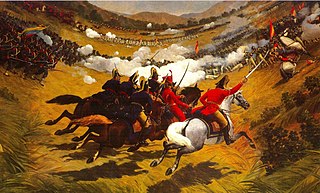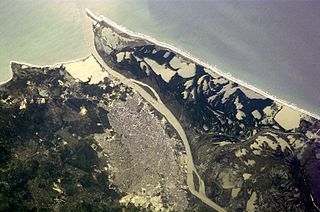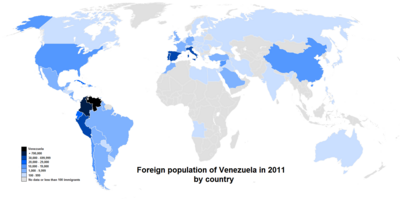
Dominicans are people identified with the Dominican Republic. This connection may be residential, legal, historical or cultural. For most Dominicans, several of these connections exist and are collectively the source of their being Dominican.

The Venezuelan War of Independence was one of the Spanish American wars of independence of the early nineteenth century, when independence movements in South America fought a civil war for secession and against unity of the Spanish Empire, emboldened by Spain's troubles in the Napoleonic Wars.
Latin Americans are the citizens of Latin American countries.
The history of the Jews in Latin America began with conversos who joined the Spanish and Portuguese expeditions to the continents. The Alhambra Decree of 1492 led to the mass conversion of Spain's Jews to Catholicism and the expulsion of those who refused to do so. However, the vast majority of conversos never made it to the New World and remained in Spain slowly assimilating to the dominant Catholic culture. This was due to the requirement by Spain's Blood Statutes to provide written documentation of Old Christian lineage to travel to the New World. However, the first Jews came with the first expedition of Christopher Columbus, including Rodrigo de Triana and Luis De Torres.
Isleños are the descendants of Canarian settlers and immigrants to present-day Louisiana, Puerto Rico, Texas, Cuba, the Dominican Republic, Venezuela, and other parts of the Americas. In these places, the name isleño was applied to the Canary Islanders to distinguish them from Spanish mainlanders known as "peninsulars". Formerly used for the general category of people, it now refers to the specific cultural identity of Canary Islanders or their descendants throughout Latin America and in Louisiana, where they are still called isleños. Another name for Canary Islander in English is "Canarian." In Spanish, an alternative is canario or isleño canario.

Immigration to Mexico has been important in shaping the country's demographics. Since the early 16th century, with the arrival of the Spanish, Mexico has received immigrants from Europe, Africa, the Americas, and Asia. Today, millions of their descendants still live in Mexico and can be found working in different professions and industries.
Eugenio Mendoza Goiticoa was a Venezuelan business tycoon who made important contributions in the modernization of the country during the 20th Century.

Eduardo Mendoza Goiticoa was a Venezuelan scientific researcher and agricultural engineer. He served the government of Rómulo Betancourt, becoming the youngest cabinet minister in Venezuelan history at the age of 28. His appointment was problematic due to his young age and required a constitutional amendment. Betancourt had insisted on the appointment and vastly expanded the portfolio of the Secretary of Agriculture to include all immigration matters.

Colombians are people identified with the country of Colombia. This connection may be residential, legal, historical or cultural. For most Colombians, several of these connections exist and are collectively the source of their being Colombian.
White Latin Americans or European Latin Americans are Latin Americans of European descent.

Immigration to Colombia during the early 19th and late 20th Century, is what makes it one of the most diverse countries in the world, above other countries in the Latin region. Colombia inherited from the Spanish Empire harsh rules against immigration, first in the Viceroyalty of New Granada and later in the Colombian Republic. The Constituent Assembly of Colombia and the subsequent reforms to the national constitution were much more open to the immigrants and the economic aperture. However naturalization of foreigners, with the exception of those children of Colombians born abroad, it is still difficult to acquire due 'Jus soli' law is not allowed by the government, and only 'Jus sanguinis' law is accepted. Immigration in Colombia is managed by the "Migración Colombia" agency.

Venezuelans are the citizens identified with the country of Venezuela. This connection may be through citizenship, descent or cultural. For most Venezuelans, many or all of these connections exist and are the source of their Venezuelan citizenship or their bond to Venezuela.

European Venezuelans or White Venezuelans are Venezuelan citizens who self-identify in the national census as white, tracing their heritage to European ethnic groups or Venezuelan citizens who have a European Surname which is not a Spanish or Portuguese surname. According to the official census report, although "white" literally involves external issues such as light skin, shape and color of hair and eyes, among others, the term "white" has been used in different ways in different historical periods and places, and so its precise definition is somewhat confusing.

The Spanish diaspora consists of Spanish people and their descendants who emigrated from Spain. In the Americas, the term may refer to those of Spanish nationality living there; "Hispanic" is usually a more appropriate term to describe the general Spanish-speaking populations of the Americas together with those in Spain. The diaspora is concentrated in places that were part of the Spanish Empire. Countries with sizeable populations are Argentina, Bolivia, Chile, Colombia, Costa Rica, Cuba, Dominican Republic, Ecuador, El Salvador, Guatemala, Honduras, Mexico, Nicaragua, Panama, Paraguay, Peru, Uruguay, Venezuela, and, to a lesser extent, Brazil, Belize, Haiti, United States, Canada and the rest of Europe.

Costa Ricans are the citizens of Costa Rica, a multiethnic, Spanish-speaking nation in Central America. Costa Ricans are predominantly Castizos, other ethnic groups people of Indigenous, European, African and Asian descent.

The Venezuelan refugee crisis, the largest recorded refugee crisis in the Americas, refers to the emigration of millions of Venezuelans from their native country during the presidencies of Hugo Chávez and Nicolás Maduro because of the Bolivarian Revolution. The revolution was an attempt by Chávez and later Maduro to establish a cultural and political hegemony, which culminated in the crisis in Venezuela. The resulting refugee crisis has been compared to those faced by Cuban exiles, Syrian refugees and those affected by the European migrant crisis. The Bolivarian government has denied any migratory crisis, stating that the United Nations and others are attempting to justify foreign intervention within Venezuela.
At the 2011 census, the number of immigrants in Costa Rica totaled about 390,000 individuals, or about 9% of the country's population. Following a considerable drop from 1950 through 1980, immigration to Costa Rica has increased in recent decades.
Basque Venezuelans are citizens of Venezuela who are of Basque ancestry.

Italy–Venezuela relations are the diplomatic relations between Italy and Venezuela. Both nations enjoy friendly relations, the importance of which centers on the history of Italian migration to Venezuela. There are approximately over 140,000 Italians living in Venezuela with more than a million Venezuelans of full or partial Italian descent.













